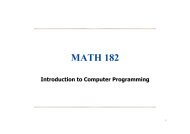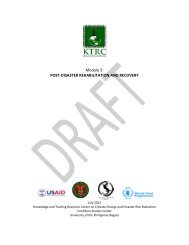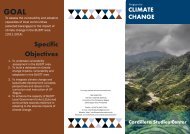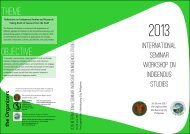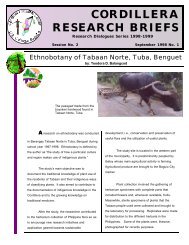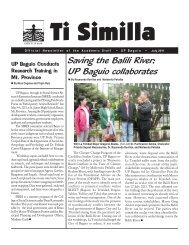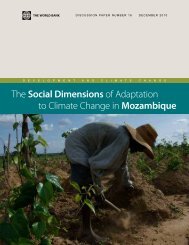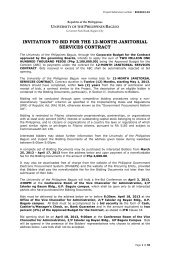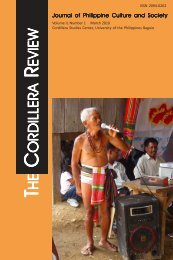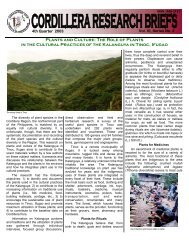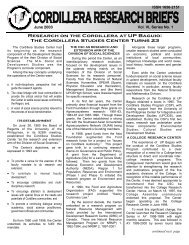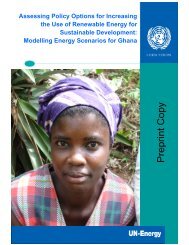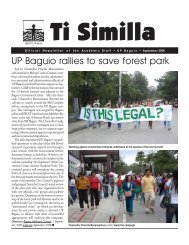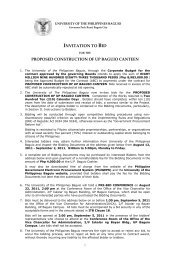August - UP Baguio
August - UP Baguio
August - UP Baguio
You also want an ePaper? Increase the reach of your titles
YUMPU automatically turns print PDFs into web optimized ePapers that Google loves.
AUGUST 2012 OFFICIAL NEWSLETTER OF THE ACADEMIC STAFF OF <strong>UP</strong> BAGUIO ISSN 0119-6634A Portrait of Chancellor RR■ by Jessica CariñoAs of presstime, Dr. Raymundo Rovillos will have beenformally installed as the second Chancellor of <strong>UP</strong> <strong>Baguio</strong>, inrites presided over by <strong>UP</strong> President Alfredo Pascual, and witnessedby System Officials, the <strong>UP</strong> <strong>Baguio</strong> community, andinvited guests from various sectors and representations from<strong>Baguio</strong> and Benguet. Ti Similla now features a comprehensiveportrait of Chancellor Rovillos, as composed by Vice Chancellorfor Administration Jessica Cariño. This was read out at theinvestiture rites.Ifirst met RR or Raymundo Rovillos in 1982. I was a youngInstructor in History and in the small group of History majorsat this time were some memorable students. Among them wereBlinky Romero with his showbiz relations, Vanguard officer RubenTinda-an, Darrow Odsey of Pagta, Theresa Mabanag who wasalways an outstanding student, Lingling Maranan who continuesto enthrall us with her nationalistic songs, Maurice Elma (whom Iwas to meet again years later in San Francisco), Lily de Vera (nowa Judge in Tarlac and a member of the new <strong>UP</strong>BAA Board ofTrustees), and RR. Mostly they were memorable because they werebright and eager to learn, and therefore created an impression onme. Also, some of them, RR included, were Fireplace habitués onthose nights when Judy and Jessica would strum and sing for someextra income.Fast forward to the present. It is a rainy Friday afternoon andI sit down with Chancellor Rovillos over salad and beer, to talkabout what has led him to where he is now – Full Professor of Historyand soon to have his formal Investiture as Chancellor of <strong>UP</strong><strong>Baguio</strong>.Having entered <strong>UP</strong> <strong>Baguio</strong> as a College freshman in 1981,Chancellor Rovillos has by now been in <strong>UP</strong> <strong>Baguio</strong> for 31 years orpractically all of his adult life. I had to start by asking him what <strong>UP</strong><strong>Baguio</strong> means to him. He tells me that his entire academic andprofessional life has been spent in <strong>UP</strong> <strong>Baguio</strong>. While he earned hisPh.D. History at <strong>UP</strong> Diliman, he earned both his bachelor’s andmaster’s degrees here. He started teaching here as a Lecturer shortlyafter his graduation with the degree AB Social Sciences (History-Political Science) in 1985, eventually becoming part-time Instructor,then full-time Instructor in 1989. He tells me succinctly that whathe is today, he owes to <strong>UP</strong> <strong>Baguio</strong>. His teaching job was his breadand butter, especially when he assumed the role of breadwinner forhis family with the retirement of his parents. But more than simplythe material benefits, he says that <strong>UP</strong> <strong>Baguio</strong>trained him andhas molded him into what he is today.During those years as a student,RR never imagined himself as one dayassuming the role of academic leader andadministrator of <strong>UP</strong> <strong>Baguio</strong>. He tells methat he never saw himself in the position ionhe is in today, even while he knew for thelongest time that he wanted to be a teacherand to pursue an academic career.I ask him to tell me about some ofthe personal or professional milestones sthat made him decide to pursue an aca-ademiccareer right here at <strong>UP</strong> <strong>Baguio</strong> andI sit down withChancellor Rovillos over saladand beer, to talk about what has ledhim to where he is now►4 SummerArts ExtensionProgram 2012■ Rosario Florendo►4-5Painitinang Malamig ...■ Leticia Tolentino►6-8Faculty Updates■ Jennilyn Calamiong■ Karen Ballada■ Ceres Canilao►9-10Darnay Tribute II■ Ceres Canilao■ Jonizar Mejia►11 South ofNorth Pole■ Juancho Collera
Featurehow his professional development took on the contours of the paththat it has actually taken. The Chancellor recalls that, as a student,he admired his professors and looked up to them as role-models.In this regard, he specifically mentions Prof. Lydia Casambre andProf. Rowena Boquiren; incidentally, he also mentions Prof. JessicaCariño (but maybe that’s just because I am sitting across the tablefrom him). He always strived to emulate these mentors so that oneday he could be like them.Like many <strong>UP</strong> <strong>Baguio</strong> students who came before or after him,RR became a student activist and, for a time, his career took a backseat. “I had no career plans but to serve the people, to pursue myidealism, and to serve the Cordilleras.” His work as an organizer wasin the education sector, and he was tasked to work with EducationForum and the Alliance of Concerned Teachers. This gave him theopportunity to travel to the remote villages of the Cordillera. Fortunatelyfor him and for <strong>UP</strong> <strong>Baguio</strong>, his organizing work involvedteachers and the education sector and thus allowed him to acceptthe position of lecturer and eventually part-time faculty with <strong>UP</strong><strong>Baguio</strong>.In 1989, RR took some time off from his organizing work toreflect on his social engagement, and decided to accept the invitationof Prof. R.Boquiren to join the History faculty on a fulltimebasis. Since then, there was no turning back from his pursuit of anacademic career at <strong>UP</strong> <strong>Baguio</strong>. Even while carrying a full teachingload (at times, teaching overload) as a junior faculty member,RR grabbed opportunities to be involved in research work. Herecalls that one of his earliest research involvements was as facultyChancellor Rovillos (center) with Prof. Arellano Colongon, Jr. (left), and Dr.Santos Jose Dacanay IIIresearcher in a UCIDS-funded research on internal refugees in theMarag Valley of which I was the Project Leader. On top of histeaching, research and committee work assignments, RR decidedto enroll in the MA Social and Development Studies program evenwithout the support of a faculty fellowship. He consistently enrolledin 6 units in the program every semester until he completedall his academic requirements, passed the comprehensive exam andsuccessfully defended his thesis, thereby earning his MASDS degreein 1996.The Chancellor is very proud of the training he received from<strong>UP</strong> <strong>Baguio</strong> both as student and as junior faculty. As a student, hebenefited from the mentoring by top-caliber faculty in both the undergraduateand graduate levels. He is proud that he was provideda very strong theoretical grounding in the social sciences, whichallowed him to participate confidently in academic discussions whenhe went on to do his doctoral studies in Diliman. The interdisciplinaryorientation of <strong>UP</strong> <strong>Baguio</strong>’s social science program also gavehim a solid exposure to the different social science disciplines andallowed him to look at social issues and problems in a comprehensiveway. As junior faculty, the mentoring that comes with beingassigned to teach major courses and involvement in research activitiescontributes to the personal and professional growth of youngfaculty members. <strong>UP</strong> <strong>Baguio</strong>’s academic niche in Cordillera studiesalso opens a lot of opportunities, especially now that indigenouspeoples have become a global concern. That focus on the Cordilleraand issues of ethnicity allowed him to gain international exposure.Chancellor Rovillos reveals that he took on the challengesposed by the expectation of a multitasking <strong>UP</strong> faculty memberbecause he wanted to earn his tenure. Clearly by this time, he hadresolved to devote his professional life to <strong>UP</strong> <strong>Baguio</strong>.Even as he accepted the position of fulltime faculty memberat <strong>UP</strong> <strong>Baguio</strong>, he continued to embrace the ideals and vision for arelevant transformative education which was his advocacy as a socialactivist. Thus he continued to maintain his links with the NGOsector and indigenous peoples’ organizations. He says that his workat <strong>UP</strong> <strong>Baguio</strong> in fact allows him to work towards the fulfillmentof his personal ideals and vision for a relevant and transformativeeducation. It is also in this regard that he finds the administrativepositions of Dean and Chancellor gratifying.I asked the Chancellor to identify some of the priority concernsthat he would like to focus on at the outset of his term. Oneis to revitalize the Cordillera Studies Center. He recalls the timewhen the CSC was a dynamic research center of what was thenthe Social Sciences Division. It was a busy research hub providingadministrative and technical support to faculty members involvedin various continuing research projects and programs. ChancellorRovillos misses this dynamism in <strong>UP</strong> <strong>Baguio</strong>’s research function andthus would like to reinvigorate the research culture in the University.Another is to revive the cultural scene at <strong>UP</strong> <strong>Baguio</strong>. Chancellor2 TI SIMILLA<strong>August</strong> 2012
A full summer for the 2012Summer ArtsExtension Program (SAEP)■ by Rosario FlorendoEvery summer, the College of Arts and Communication holdsits Summer Arts and Extension Program(SAEP). This is thefourth since the program’s revival under the leadership of thenDean, Prof. Elizabeth Calinawagan. This year’s SAEP successfullycatered to children, young adults and professionals whoseworkshops were led by facilitators who are experts in their respectivefields. Workshops were divided into two weeks with a varietyof offerings. Week one, held from April 16 to 21, consisted of 6workshops with facilitators from the Fine Arts faculty and a guest,Wafey Casem (member of <strong>Baguio</strong> Photography Club). First weekworkshops were on: Drawing for Adults, Watercolor, Jewelry Makingfor Kids, Drawing for Kids, Soft Sculpture (Plaster) and DigitalPhotography. Week two, held from April 23 to 28, offered Cartooning:Character Design, Acrylic, Drawing for Kids, Painting for Kids,Pastels and other Dry Media, and Advanced Digital Photography.These workshops were primarily designed to train young arts enthusiastsin developing their talents while these students are on theirsummer break from school. An exhibit cum graduation was held onthe last workshop day; parents of participants were among guestswho viewed the creative works on display.Another component of this year’s SAEP were the off-campus,community-based workshops. This year’s chosen community wasKapangan, Benguet. Led by Dean Purificacion Delima and Departmentof Communication Chair Prof. Jimmy Fong, the group ofMALL students enrolled in Ibaloi class, Department of Communicationinstructors Reyness Joy Abellada and Mr. Christian EzekielFajardo travelled to Kapangan, Benguet to hold 3 workshops. Theseworkshops were on Heritage Language Revitalization, CommunityJournalism and Speech Communication. This off-campus triplikewise served as community exposure for students in Prof. Fong’ssummer Intensive Ibaloi class consisting of both undergraduateand graduate students in language and literature. At the same time,MALL students were also given a taste of community immersionand data gathering for research which would eventually be usefulfor work on their theses.The highlight of the SAEP was the hosting of a TESOL CertificateCourse offered by the Asian EFL Journal Group headed byits CEO, Dr. Paul Robertson. This catered to teachers, students andother interested participants, with or without teaching background/experience, who wanted training in teaching English (and were eyeinga teaching post overseas). This 10-day TESOL Course was heldfrom May 7 to 18 and was attended by 21 participants including 2from the Department of Language, Literature and the Arts faculty.The course included classes in teaching methods, listening and pronunciation,research, and a teaching demonstration. ■ReportPainitin moang malamig kongAgosto■ by Leticia TolentinoCommon ground, SocSci lunch tablesIt’s more than just a teasingtitle, but is one of thosemonthly themes of Soc Scigatherings where food anddrink, (ooops …not what you’rethinking) appetizers and dessertsreceive creative descriptionsand/or names. Lunches inthe College of Social Sciencesassume a different perspective,thanks to a supportive deanand a bunch of creative facultyand staff. Can you imagine acongerie of menus concoctedinterdisciplinarily? For instance,Emile Durkheim’s organicsolidarity (for fresh gardensalad), Adam Smith’s Wealth ofNations (for fruit salad), ImmanuelKant’s Pancit Kanton,John Locke’s RevolutionaryCupcakes, Margaret Meadballsor Karl Marx’s Alienated Drink.Usually conceived asreprieves from the tiresomegrind of day-to-day academiclife, these lunches allow thefaculty to be themselves, lettingtheir hair down to exchangepleasantries, crack jokes, whilerelishing the various foods theyeither prepared or bought fromthe stores.This exodus to the facultylounge started as a simple celebrationof birthdays usuallyheld during monthly facultymeetings when Soc Sci was justa division of then <strong>UP</strong> College<strong>Baguio</strong>. The birthday celebrantswould meet to agree on what tofeed their peers and share thecost. Ordinarily, the agreementwould be just simple but nourishingfood - a delightful mealtaken after the frequent heavymeetings yet, almost always, theofferings were beyond expectations.From these celebrations,the fever caught on so that evenon ordinary days, a small groupof “lunch breakers” wouldgather at the old SSD loungeand shared their “baon.”Way back in the 90s, whenI came to <strong>UP</strong> <strong>Baguio</strong>, I became4 TI SIMILLA<strong>August</strong> 2012
a member of this group oflunch breakers. I rememberhow every weekday, we wouldagree to have lunch togetherand share some of our specialties.On occasions, the groupwould coax Florence Salinas,the late Lulay Hamada, GladysCruz or Tala Ramos to cookfor us. Of course, they wouldoblige. Florence would, in thenext few days, come up with hervery delectable cocido, lengua orpochero Español. Lulay wouldbring chocolates instead of herpromised recipe, Gladys would,to the delight of everyone, bringher yummy brownies or tunapasta, or anything she had bakedthe previous days. Tala, on theother hand, would bring salad,Lelet would add up with herusual packs of chicharon baboy,fresh from Bulacan, Maanwould opt to buy grilled milkfishfrom Engineers’ Hill, andalthough not in sync with whateveryone had brought, I camewith my pot of “uung, ampalayaand pasayan.”When the old SSD buildingwas demolished, the facultytransferred to the library buteven with the cramped spacesthe faculty shared, the practicelived on. It grew in proportionwhen Soc Sci occupied its newbuilding. The distance betweenthe new building and the canteensbecame a factor, whichfurther enhanced lunch breaks,baon style. Most faculty broughttheir packed lunches or sandwiches.Going to the canteenswas a tedious task especiallyafter teaching several hours orwhen the rainy season came.So lunch was not only a respitebut a time to communicate andcommune with friends and colleaguesin the college.So semester after semester,the practice continued untilit became bigger. From dailylunch breaks, faculty lunchesbecame monthly fares. They,too became complicated butexciting - thanks to Thea whoconcocts the provocative or enticingtitles or themes to assurea diverse assortment of goodiesFeatureto partake of and enjoy. Froma menu of hot and spicy tosweet and nutty, from Filipinoto foreign delicacies – all thesebring out all imaginable offerings.Everyone simply looksforward to these first Friday ofthe month events. (A changehas taken effect this semester,though. Instead of first Fridays,The Chancellor (center) with colleagues Gladys Cruz (left) and MaileenitaPeñalbacelebrations are now held everyfirst Thursdays to ensure thatleftovers get “demolished” thenext day.)It goes without saying thatfood served during these daysdo not always necessarily borderon the healthy side. Crispypata, adobo, kaldereta, karekare,dinuguan, and sinugbangbaboy may creep on the tableonce in a while, but there’salways fish and veggies to balancethese off. Dinengdeng,laing or ginataang gulay areoften best sellers. A pinch hereand there, or a piece from aroasted chicken or grilled fish ormeat and a thin slice of cake orbibingka are more than enoughconsolation for those with “dietimpediments.” (Tired of usingdiet restrictions, sorry). Freshgarden salad and fruits load thetable, too, plus an assortment ofdesserts that some continue toenjoy during their vacant hours.The Soc Sci dining table islong and wide but it is never toolong nor too wide to accommodatewhat the faculty bringeither individually or in groups.Instances prove that we contaminateothers with this activity.Visitors come unexpectedlysometimes, take delight in whatloads the table and get mesmerizedby the kind of bond thefaculty and staff share. Truly,in Soc Sci, the motto continuesto reverberate – “In food, weunite.” ■Academic potluckFood for thought<strong>August</strong> 2012 TI SIMILLA5
Faculty UpdatesCollege of Social SciencesLeadership Skills and the Department of Economicsand Political Science■ by Jennilyn CalamiongThe Department of Economics and Political Science (DEPS), merged with the Institute of Management, has grown more dynamic withthe opening of schoolyear 2012-2013. New leadership roles have found their way into the department. Dr. Lorelei Mendoza, CSS’ solenominee during the selection process held last April and May, is appointed CSS Dean. She is also a full-time professor of Economics. Dr.Alejandro Ciencia, Jr. is now Director of Cordillera Studies Center, the official research arm of <strong>UP</strong> <strong>Baguio</strong>. He received the InternationalPublication Award last 2011 for his paper, “The Philippines SC’s Ruling on the Mining Act: A Political Science Perspective.” Dr. CorazonAbansi, former Directeor of the Institute of Management, now serves as Director for Student Affairs. Meanwhile, Prof. Jay Stephen Siy isappointed new IM Director. Prof. Gladys Cruz now chairs the Faculty Evaluation Committee (FEC), a position she held in 2009 prior toher appointment as CSS College Secretary the following year. Also, Prof. Erlinda Castro-Palaganas is National President of ALL <strong>UP</strong> AcademicEmployees Union. DEPS in particular is now chaired by Atty. Nimreh Calde, Assistant Professor of Political Science. He also servedas the SRO of <strong>UP</strong> <strong>Baguio</strong> in 2006-2007 and June 2009- May 2012.DEPS also welcomed back Prof. Arellano Colongon, Jr. of Political Science from his sabbatical leave in 2011. During his leave, heworked on a bibliographic survey of studies on Cordillera Governance and Political Institutions published in the last 30 years. It is a jointproject with Professor Emeritus June Prill-Brett and is part of the Golden Jubilee Lecture Series of the Cordillera Studies Center that runsfrom 2011 to 2012. DEPS also welcomed back a <strong>UP</strong> <strong>Baguio</strong> alumnus, Mr. Rainier Ric dela Cruz, as the newest member of the faculty. Mr.dela Cruz teaches Macroeconomics (Econ 101) and Statistics for the Social Sciences (SS 101). He graduated from <strong>UP</strong> <strong>Baguio</strong> last April2011.Leadership entails responsibility. At times, it becomes a question of willingness and desire. But on top of that, it boils down to competence.It is something you don’t just assign to anybody. On the other hand, leadership can be a matter of perspective and disposition. AsProf. Ciencia expressed during the DEPS Democratic Consultation held last May, leadership is so much like a reward. People assign to youpositions because they recognize your possible contributions.It takes skills to become leaders, and DEPS is up for the challenge of “<strong>UP</strong> <strong>Baguio</strong> reaching greater heights!” ■The College of Social SciencesUniversity of the Philippines <strong>Baguio</strong>congratulates<strong>UP</strong> INTERNATIONAL PUBLICATION AWARDEESAlejandro N. Ciencia Jr.Department of Economics and Political SciencesFrom Judicialization to Politicization of the Judiciary. In B. Dressef (Ed). The Judicialization of Politics in Asia (pp.117-138).Oxfordshire, UK: Routledge, 2012.Raymundo D. RovillosDepartment of History and PhilosophyRovillos, R.D., & Tauli Corpuz V. (2012) Development, Power and Identity Politics in the Philippines. In S. Sawyer and E.T.Gomez (Eds). The Politics of Resource Extraction: Indegenous Peoples, Multinational Corporations, and the State (pp. 129-152). London andNew York: Palgrave McMillan.Analyn Salvador-AmoresDepartment of Social Antrhopology and PsychologyBatok (Traditional Tattoos in Diaspora: The Reinvention of a Globally Mediated Kalinga Identity, South East Asia Research,19,2, pp 293-318, June 2012.6 TI SIMILLA<strong>August</strong> 2012
Faculty UpdatesCollege of ScienceFaculty and Staff meet for July’s BAON-BIDAHAN■ by Karen BalladaThe College of Science, through its Socials and Lecture Series Committees, held the CS Baon-Bidahan last July 26, 2012, over lunch atthe CA Faculty Lounge, courtesy of new CS faculty members. New faculty members of CS are Danielle Rose Tan, Rose Angeli Rioja,Eloise Dorothy Gamit, Virchel Joy Digal, Graziel San Luis and Kathleen Dizon. The activity, headed by Deemson Mones and PhoebeChloe Ramos, aims to bring together CS faculty members to hear monthly updates and experiences of faculty who attended seminars,workshops, and conferences. Majority of speakers this time were from the Biology Department. Wilen Mina attended a round table discussionon HIV and Immunology on June 20; Aris Reginaldo, Celia Austria, and Dora Balangcod participated in the “Monitoring Ecosystems100” training workshop on June 21-22; and Liezel Magtoto and Deemson Mones’s attended the Scientific Forum on Emerging Technologyon July 12. ■College of Arts and CommunicationUpdates■ by Ceres Canilao1. Visiting Professor Dr. Maria Rocio Casanova lectured on “Spanish American Modernism and the Generation of 1898” on July 18 and“Latin American Fiction: Boom, Post-boom McOndo, Crack Literature” on <strong>August</strong> 17, 2012; the lectures were sponsored by the TalastasanLecture Series.2. Junley Lazaga was featured in the book entitled Alimpatok: Antolohiya Dagiti Erotiko a Daniw nga Ilokano, launched at the <strong>UP</strong> <strong>Baguio</strong>Library on <strong>August</strong> 3, 2012.3. In celebration of the 32nd Anniversary of the Cordillera Studies Center (CSC), “Negotiating from the Margins” lectures were held at <strong>UP</strong><strong>Baguio</strong> on July 4; “Negotiating Identity in Contemporary Philippine Children’s Stories,” by Dr. Anna Christie Torres; “Socio-Cultural Discoursein Public Utility Vehicles in <strong>Baguio</strong> City, Philippines,” by Dr. Rosalina Mendigo; “The <strong>Baguio</strong> Cine: Cinema and City, Modernity,and Hybridity,” by Dr. Rina Locsin; and “Relocating and Translating American Country Music in the Northern Philippine Cordillera,” byDr. Jimmy Fong. These lectures were first delivered at the 13th Annual Convention of the Media Ecology Association in New York, Juneof this year.4. Ceres Canilao attended a Creative Pedagogy Workshop organized by the College of Social Sciences and Philosophy and the <strong>UP</strong> Centerfor Women’s Studies (<strong>UP</strong> CWS ) at <strong>UP</strong> Diliman, July 30-31, 2012.5. <strong>UP</strong> Fine Arts faculty Liza Ann Ilagan, Ceres Canilao, Joseph Andrew Carvajal and Jhoan Medrano have started skills training inwoodcarving. The 10 session training is being handled by woodcarver Ernesto Dul-ang and will go on till September 2012. ■<strong>August</strong> 2012 TI SIMILLA7
A Portrait of Chancellor RR(continued from page 3)what is now recognized as his slogan or even battle cry, “to bring<strong>UP</strong> <strong>Baguio</strong> to greater heights.” It is a recognition that the Universityhas already accomplished so much over the years, and that it is nowtime to make the world take notice of <strong>UP</strong> <strong>Baguio</strong>. He would like tosee the consolidation and expansion of the University’s programsand to bring these to the attention of the regional, national andinternational community. At the same time, he wants to restore theregard for the humanity and self-worth of University employees,and the feeling of belonging and ownership, and the sense of communityamong University constituents.I get curious. I know how lonely it can be at the top. I ask himwhat he does to unwind after work, or what gives him refuge whenthings get really tough at the office. He admits that he had to giveup a lot of his personal and social life when he accepted the positionof Chancellor. He is thankful for the support of his family,consisting of sisters, brothers, nieces, nephews and even apos. Headmits that “spending time with my apos is the best.” He also hasa circle of tried and tested friends, many of whom are <strong>UP</strong>B alumniwho have stood beside him. They help to keep him grounded andto maintain an objective perspective on things. When things getreally difficult, he goes out of town, perhaps to see a friend and dosomething totally relaxing and unrelated to work – maybe visit afarm or go to the beach.Rewind to 1982. One of the classes I am handling is a courseon Philippine Revolution (History 115). RR is one of my students.FeatureInvestiture PhotosKaraoke with Prof. Gladys Cruz, Carol Brady and Laney De RaedtBack from my interview with the Chancellor, I decide to dig upthe records and, out of curiosity, take another look at the Report ofGrades I submitted for that History 115 class thirty years ago. Well,well, well… I feel a sense of confirmation. RR is one of three studentswho merited the highest grade I gave in this class. Well done,RR. Congratulations, Chancellor!■8 TI SIMILLA<strong>August</strong> 2012
In Memoriam“And this gives life to thee….”:A Tribute to Sir Darnay■ by Ceres CanilaoLong silver hair, distinctly-framed glasses, and a sport seat which doubled as a cane. It was very hardto miss Sir Darnay when he was around the old Fine Arts Building. He was the father of the FineArts Program. This is not just because he was one of the founders, but also because he was alwaysa patient teacher. He explained creative methods and procedures step-by-step and he monitored theprogress of our plates closely to make sure that we were doing things correctly. We felt his genuineconcern for our growth as Fine Arts students.I remember one afternoon, coming to school carrying a pile of lumber, a hammer, and a saw. Iwas a lot skinnier back then and looked quite ridiculous carrying all these heavy carpentry materials. Iwas about to commence the daring task of making my own stretcher or frame. This was going to beused for my painting class under a different professor. (Back then we had to make and stretch our ownframes because there was no National Bookstore yet). Anyway, I angled a piece of lumber and startedto saw with all my might. I twisted, and turned, straining my feeble muscles. I ended up cutting thewood quite unevenly. I was sighing in frustration when I noticed the presence of Sir Darnay. He hadseen what had happened from afar and was approaching to ask me what I was trying to do. I timidlyexplained my predicament to him. He carefully picked up the wooden piece of shame and brought itinside the workshop. He secured it firmly to a clamp, (and until that day I had no idea what a clamp wasfor) and started to demonstrate how I could make a clean vertical cut on the wood. “First you makea line, then you make sure your saw is straight. You don’t have to force it, just let the teeth of the sawgnaw on the wood.” And true enough, he made a very clean vertical cut on the wood quite instantly andquite effortlessly. He turned over the saw to me so that I could give it a try on the other edge. I did itexactly as he taught me and I was able to duplicate the feat. Probably not as effectively as he did, but itwas a far cry from my original disaster.As ordinary as it may seem, this memory is one of the fondest I have of this great teacher. He wasnot really my professor in that class, but without the knowledge that he shared I would not even be ableto start a single painting. What also makes this seemingly trivial event special for me is the way he effortlesslysawed on that wood. . . That was just so like him. . . He was simple, quiet, and very controlled;but his works are powerful, passionate, and perfect-- perhaps sublime. And he is kept alive by the art heleft around us and the priceless lessons that he taught. And like a line from Shakespeare which I learnedthrough his beloved, Ma’am Flor Hernandez, his works and lessons will go a long way: “So long livesthis, and this gives life to thee.” ■<strong>August</strong> 2012 TI SIMILLA9
In MemoriamSir Darnay: Artist, Teacher■ by Jonizar MejiaMy first encounter with Sir Darnay’s art was when I was alittle kid, probably around five years old. My dad tookhome a painting then, about 18 by 24 inches. It was a rendition ofa woman done in hues of greens and blues. The woman, wearing asimple blouse and with her hair down, was eliciting a rather furtivelook, albeit a shy one. That painting is now part of our family, as ithas been with us for almost three decades. In fact, I have this paintingproudly displayed in my room. That artwork, that shy aquamarinelady holding her secrets to herself, is a Darnay.Fast forward twenty years later, and I return to this university inpursuit of the course I was really passionate about. I had come torealize that a couple of years working behind the desk as a consultantfor a computer school wasn’t working out for me, so I decidedto finally pursue Fine Arts. I thought I already knew all the basicsabout art and then some, since I supplemented my practiced skillswith reading a handful of art books. But under the tutelage of SirDarnay, I was immediately proven wrong.Two things I will not forget about what Sir Darnay taught mewas that, for one, my rendition of human ears wasnot that good. He also emphasized the importanceof capturing the proper proportionsof the human head, constantly scrutinizing thesubject until you get a good resemblance. Heemphasized so well that he made us sketch all ourclassmates’ faces until he saw a marked improvement.These two things I now have committedto memory. Firstly, attention to details counts fora lot (as in taking pains to render small parts ofthe body like the ear, for instance), and secondly,habitual practice will make you better.Sir Darnay had a couple of pet peeves which he never failedto share to his students. One, when painting in color, avoid usingblack, and two, when you sketch, never ever smudge. For Sir Darnay,using black makes for duller-looking paintings, and when onesmudges a sketch, it is the lazy way out. For him, there can be noshortcuts. For these lessons, I am grateful.The great thing about Sir Darnay is that, no matter how quiethe seemed, all of us sensed the profound passion he had not onlyfor his art, but for the art of his students. He didn’t scrimp on whathe knew; he shared to us everything he knew about art: how to usea particular color different from real life so that your artwork willlook more alive, how to create texture in watercolor, creating positiveimages out of negative space. It became increasingly evidentthat Sir Darnay was not only a great artist, but a great teacher aswell. And as a teacher, that was what made Sir Darnay great, hisunwavering concern for the artistic growth of his students. Askanyone who became his student. They will substantiate this to afault.As with all good things, though, there comes an end.But even though Sir Darnay has already left us, hislegacy will long live on. For all that he had done forus, Isimply would like to say, thank you, Sir Darnay,my mentor, my teacher, our inspiration. Asyour students’ works shall be continuouslyborn into this world, so your influence andyour quiet inspiration shall be passed on. ■Jonizar Mejia is an alumnus of <strong>UP</strong> <strong>Baguio</strong>,graduating with a BA in Social Sciences (1997)and a Certificate in Fine Arts (2005)Caricature by Jonizar Mejia10 TI SIMILLA<strong>August</strong> 2012
Travelling ScholarSouth of North Pole■ by Juancho ColleraQueen’s University at Kingston, OntarioFive years ago I was acceptedinto the PhD Math place of my own. They werefor a few days until I found aprogram at Queen’s University very helpful and accommodating.They even gave me a key toin Kingston. It all started whenI emailed my future supervisor their home. The following dayto ask if he was willing to take was a warm end-of-summer day,me in as a graduate student. I got my school ID and finishedThis was followed with a formal registering for my courses. I wasapplication, and submission assigned an office at the basementof Jeffery Hall.of required documents suchas my transcript of grades and Classes started and leavesTOEFL scores. And so, after I began to fall. I took the coretravelled literally halfway around courses and some electives thatthe globe, my doctoral studies connect to my research area.began in the Fall of 2007. Soon dried leaves were replacedI arrived at Kingston bus with snow. Both of these madeterminal the night before the a crunching sound as I walkedlast day of registration. The city on them. My first two yearsof Kingston is located halfway at Queen’s were spent takingbetween Toronto and Montreal, courses after which I took aand was Canada’s first capital comprehensive examination andcity. I was greeted by a local passed. While taking courses, Iwho volunteered to host me also worked as a teaching andresearch assistant to pay mytuition and other fees, whichis the typical set-up for graduatestudents specially in NorthAmerica. I was tasked as a lableader for an undergraduateengineering course. I spent mostof my time in the computerlab helping students with theirprogramming work.Thesis work actually startedas early as my second year. Mysupervisor would encourage meto attend conferences and seminarsthat were relevant to myresearch topic. It is also in theseevents where I would meet bignames in my field, like authorsof textbooks I been studying. Ifelt privileged sitting and listeningto their talks. I attended alot of conferences, seminars,and summer schools, mostly inOntario and Quebec. And in mylast two years, I presented theresults of my research, going asfar as St. John’s, Newfoundlandwhich is on the easternmostpart of Canada and to Vancouver,BC in the west.The first part of my thesisis a theoretical result that dealswith a centre manifold reductionfor delay differential equationsthat preserve symmetryproperties, while the secondpart studies symmetry-breakingbifurcations in rings of delaycoupledlasers. My topic isin fact a mix of analysis andalgebra, theory and numerics.I learn tools from equivariantdynamical systems and numericalbifurcation analysis.My thesis examination washeld on the first week of March2012. I returned to <strong>UP</strong> <strong>Baguio</strong>last April and was greeted withsmiles from my former colleagues.I taught a graduatecourse in Complex Analysis lastsummer term while I did revisionsfor my thesis. By the endof April I finished all revisions.It was my supervisor who firstcongratulated me; in his words“You have worked very hardin some difficult situations, butyour perseverance and hardwork has paid off.” The firstthing I did, after submittinga PDF copy of my thesis toQueen’s library and after applyingfor graduation online, wasto sleep.I have come full circleto where I am five years ago.<strong>August</strong> 2012 TI SIMILLA11
Travelling ScholarBIFURCATIONSOF PERIODIC SOLUTIONSOF FUNCTIONALDIFFERENTIAL EQUATIONS WITHSPATIO-TEMPORAL SYMMETRIESDr. Collera at Capilano in Vancouver, BCOlder and wiser, but my heartremains young. It has to be likethat. I hope that people wouldremember this not as a storyof someone who succeededin finishing his doctorate in aforeign university, but as a storyof a collective effort of peoplewho helped me along the way.The days that I spent workingon my PhD are the days that mywife single-handedly raised ourchildren, days that I should havebeen hugging my kids while puttingthem to sleep, the days thatI should have been kissing mywife just because I wanted to.Here’s what I wrote on myapplication form to Queen’sunder Statement of Interest:“Pursuing a PhD in Mathematicswill put me in a betterposition to help my university,particularly my department, inrealizing its goals. With a doctoratedegree, I will be able toteach on our graduate program,do more research and collaborations,and significantly contributeboth to my university andto the community as a whole. Itwill definitely open new doorsfor me. Aside from fulfilling mylong time dream, I think thatit will help me grow not onlyprofessionally but personallyas well. But more than theseopportunities, I think the mostimportant benefit of a PhDdegree is the chance to reachout to more people and be aninspiration to others.”■ABSTRACTIn this thesis, we study bifurcations of periodicsolutions with spatio-temporal symmetries of functionaldifferential equations (FDEs). The two main results are: (1)a centre manifold reduction around a periodic solution ofFDEs with spatio-temporal symmetries, and (2) symmetrybreakingbifurcations for symmetric rings of delay coupledlasers.For the case of ODEs, symmetry-breaking bifurcationsfrom periodic solutions have already been studied.Our goal is to extend this result to the case of symmetricFDEs. We use a Centre Manifold Theorem for FDEswhich reduces FDEs into ODEs on an integral manifoldaround a periodic solution. We prove a similar result thatapplies to symmetric FDEs, and show that the integralmanifold is invariant under the spatio-temporal symmetries.This guarantees that the symmetry structure of the systemof FDEs is preserved by this reduction. We also considera problem in rings of delay-coupled lasers modelled usingthe Lang-Kobayashi rate equations. We classify the symmetryof bifurcating branches of solutions from steady-stateand Hopf bifurcations that occur in 3-laser systems. Thisinvolves finding isotropy subgroups of the symmetry groupof the system, and then using the Equivariant BranchingLemma and the Equivariant Hopf Theorem. We then utilizethis result to find the bifurcating branches of solutionsin DDE-Biftool.Symmetry often causes eigenvalues to have multiplicity,and in some cases, this could lead DDE-Biftool toincorrectly predict the bifurcation points. We address thisissue by developing a method of finding bifurcation pointswhich can be used for the general case of n-laser systemswith unidirectional and bidirectional coupling.■Dr. Juancho ColleraOffice of Public Affairs<strong>UP</strong> BAGUIO2600 <strong>Baguio</strong> City, PhilippinesENTERED AS SECOND CLASS MAIL AT THE <strong>Baguio</strong> City Post Office,Upper Session Road, <strong>Baguio</strong> City WITH PERMIT NO. CAR-08ISSN 0119-6634Published by the University of the Philippines<strong>Baguio</strong> through the Office of Public AffairsE-mail: opa@upb.edu.ph<strong>UP</strong> <strong>Baguio</strong> website: www.upb.edu.phEditor: Victoria CostinaAssociate Editors: Jimmy Fong, Ruth TindaanStaffwriters/College Information Officers:COLLEGE OF ARTS AND COMMUNICATION:Ceres Canilao| Linda Cariño| Francisco RosarioCOLLEGE OF SCIENCES:Karen Ballada| Jennifer Inovero| Quantum Lubrica|Phobe RamosCOLLEGE OF SOCIAL SCIENCES:Jerry Bancawayan| Jennylyn Calamiong| Leticia TolentinoLayout & Artwork: Ceres CanilaoLogistics: Frederick PedregosaThe views and opinions expressed in TI SIMILLA do not necessarily reflect the collective stand of the academic staff or theofficial position of <strong>UP</strong> <strong>Baguio</strong>



